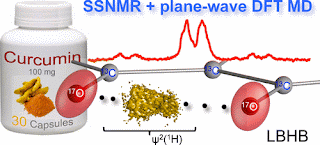A spicy scientific scandal

I am often on the lookout for interesting molecules and solids which involve short hydrogen bonds, particularly biomolecules where this bond may play a key role in functionality . Such bonds are of interest from a physics point of view because then the quantum motion of the proton matters. Consequently, the following paper (published in October 2016) caught my attention. Proton Probability Distribution in the O···H···O Low-Barrier Hydrogen Bond: A Combined Solid-State NMR and Quantum Chemical Computational Study of Dibenzoylmethane and Curcumin Xianqi Kong, Andreas Brinkmann Victor Terskikh, Roderick E. Wasylishen, Guy M. Bernard∥, Zhuang Duan∥, Qichao Wu∥, and Gang Wu The authors state their motivation. Curcumin was selected in our study, in part because it is being touted as a wonder drug and is of intense interest to the pharmaceutical and medical community.31−33 This sounds quite exciting. Could low barrier hydrogen bonds be important in curing cancer? Curcumin is a maj


